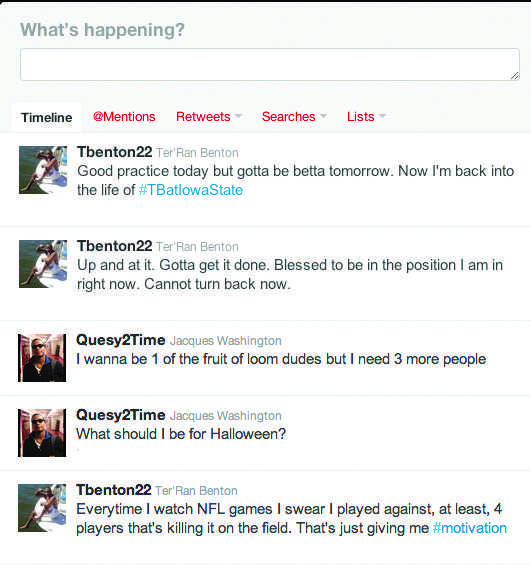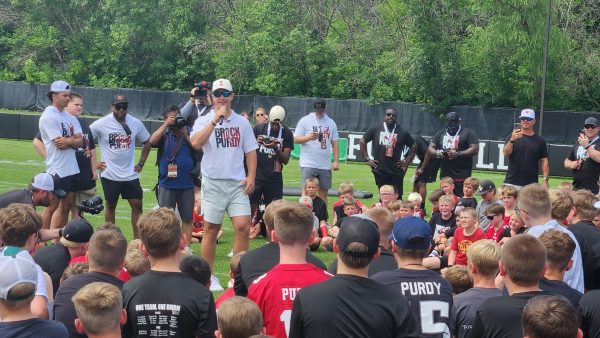ISU athletic department embraces social media

Twitter and its page layout is a registered trademark of Twitter Inc.
Many athletes take advantage of social media such as Twitter and Facebook.
October 19, 2011
With more eyes locking in on missteps and infractions in college athletics, social media use by student-athletes is quickly becoming a new area of focus.
More than 1,000 schools make up the NCAA and more than 430,000 student-athletes fill its schools’ teams across the country each year. With those numbers, the NCAA does not attempt to completely monitor social media, instead leaving the decisions on rules up to each individual school.
“There are a lot of different views,” said Ronnie Ramos, NCAA managing director of digital communications. “Some schools think it’s a great opportunity to show their athletes how to mature, and others don’t want the distraction.”
One team that does not care for the use of social media is the Miami football team, which banned the use of Twitter for its players. At Iowa State, no such bans are put on student-athletes from any team.
Many of the more than 400 student-athletes at Iowa State regularly use the popular social media outlets Facebook and Twitter, and the athletic department views the use as a valuable asset to communicate with fans.
“I think it’s another way for our student-athletes and our coaches to engage with the fans and that’s a positive,” said Associate Athletic Director Steve Malchow. “Any engagement you can get — whether it’s signing autographs after a game, coming to a family fun day or interacting with them via social media — I think is a positive.”
As scandals and investigations become more prevalent in college athletics, social media use has become more closely monitored and more broadly talked about.
Ramos said the only regulations the NCAA currently has are in regards to contact between coaches and prospective student-athletes. The rules were put into place to keep recruits from being inundated with messages, but Ramos said the missteps are often times minor.
“We do some monitoring, but the schools self-report. Those are secondary violations that do happen,” Ramos said. “We are in the process of evaluating our rules for the long-term, but it’s really gotten to the point where it’s self-policing.”
The NCAA does allow communication between coaches and recruits via Facebook so long as the messages are one-on-one, and Ramos said there are not very many restrictive rules.
While some athletic departments place specific rules on student-athletes, the department at Iowa State puts less emphasis on restrictions and more on teaching athletes how to use the popular medium.
“We spend more of our time in education than we do in punitive damages and trying to muzzle,” Malchow said. “We think it’s more advantageous to encourage them to do the right thing because you can only protect people so long. At some point you have to grow up, that’s what going to college is about.”
Malchow said that rather than rules, the athletic department emphasizes some basic guidelines for student-athletes and has a session dedicated to social media during their annual life skills program.
Coaches also get the message across by talking with their teams about the issues and citing specific examples when they occur. Malchow added that coaches have the ability to set rules or restrictions of their own if issues arise.
“It definitely would be a coach’s decision,” Malchow said. “If a coach felt like he or she was having problems with their team or it was a distraction, they certainly have the right to implement a team rule.”
ISU football coach Paul Rhoads allows his players to use social media, but warns them of the consequences.
“I trust the kids that I have in this program and the way we run our program that they’ll have the maturity and the responsibility to do things right,” Rhoads said. “I don’t tell them what to do and what not to do, but I hold the carrot in front of them that if they ever get out of line they could lose those privileges.”
For one ISU football player, the threat of losing that privilege is very real.
“I saw they put one of my tweets in the paper one day, and I started to become more aware and more careful,” said Jacques Washington, redshirt sophomore defensive back. “I’m a public figure, so I can’t be saying derogatory things or negative things for kids out there and just people in general.”
And while student-athletes at some institutions can’t use social media, one former ISU student-athlete feels as though Iowa State is different.
“I think it’s kind of different at Iowa State,” said former ISU quarterback Austen Arnaud. “In areas like [Miami] with a bigger draw, those guys are more viewed by the public.”
And Rhoads knows how important social media is to his student-athletes.
“It’s 2011, and social media is a way of life,” Rhoads said. “That’s the way these kids have grown up, it’s who their generation is, it’s what they do, and they enjoy that. I don’t get it, but I understand that.”
















